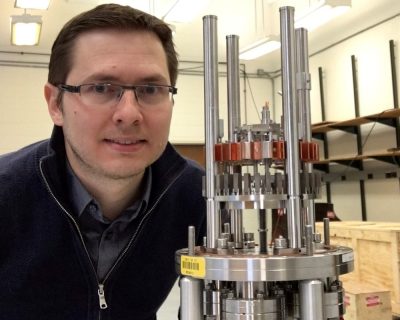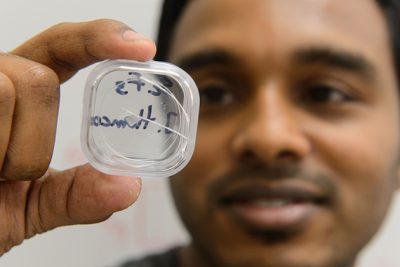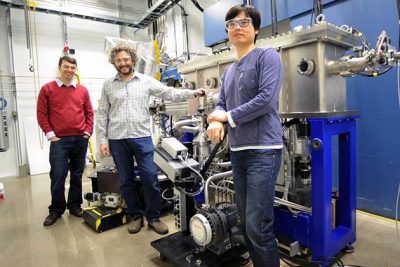The Physics Department is saddened by the passing of Professor Edward E. Eyler on September 19, 2016. Ed was a caring mentor to many students over his excellent research career. We will forever miss our friend and colleague.
Author: Richard Jones
Professor William Stwalley Retires
William C. Stwalley (Bill), Board of Trustees Distinguished Professor of Physics, has retired from teaching on June 1, 2016. He is now continuing as UConn Board of Trustees Distinguished Professor Emeritus /Research Professor of Physics and also continuing as an Affiliate Professor of Chemistry and of the Institute of Material Science (IMS).
The Physics Department would like to give a heartfelt ‘Thank You!’ and ‘Congratulations!’ to Cynthia, Michael and Bill.
Enjoy your much deserved retirement!
UConn Physics welcomes new teaching faculty




Assistant professors in residence (APiRs) are primarily responsible for teaching and managing large introductory service classes in cooperation with faculty.
The Physics Department has recently promoted Diego Valente to APiR from his former position of Visiting Assistant Professor. Congratulations Diego on a well-deserved promotion.
The department extends a warm welcome to three other APiRs, Belter Ordaz-Mendoza, Hani Duli, and Xian Wu, who are recently recruited to help advance our growth initiatives.
Employee appreciation
On Friday, April 15, the department will be hosting a special refreshments hour from 3:00-4:00PM in the Physics reading room in recognition of all Physics employees. This year we are celebrating milestones for the following people:
- Michael Rozman – 15 Years of service
- Edward Eyler – 20 years of service
- Dawn Rawlinson – 25 years of service
- Alan Chasse – 25 years of service
- Michael Rapposch – 30 years of service
Prof. Sochnikov is a recipient of Montana Instruments Cold Science Exploration Awards
 Dr. Sochnikov is a recipient of Montana Instruments Cold Science Exploration Awards Lab Startup Grant.
Dr. Sochnikov is a recipient of Montana Instruments Cold Science Exploration Awards Lab Startup Grant.
Dr. Ilya Sochnikov has just started new scanning SQUID microscopy lab at the University of Connecticut.
Ilya Sochnikov’s research focuses on nanoscale quantum phenomena in new materials. An emergence of a new phenomenon or a phase transition occurs when interactions in the materials are tuned via chemical, mechanical, or electromagnetic knobs. The material systems of an immediate interest include topological insulators, superconductors, and frustrated magnets. His main research tool will be a state of the art microscope for imaging of tiny magnetic fields at ultra-low temperatures and short timescales. One of the research motivations is to impact our understanding of materials properties that could provide new options for energy efficient technologies.
“Caution: Shrinks When Warm”

– Kim Krieger – UConn Communications
Jason Hancock, Assistant Professor in Physics, with graduate students, Erin Curry and Sahan Handunkanda, have been investigating a substance that shrinks when it warms.
Most materials swell when they warm, and shrink when they cool. But UConn physicist Jason Hancock has been investigating a substance that responds in reverse: it shrinks when it warms.
Although thermal expansion, and the cracking and warping that often result, are an everyday occurrence – in buildings, bridges, electronics, and almost anything else exposed to wide temperature swings – physicists have trouble explaining why solids behave that way.
Research by Hancock and his colleagues into scandium trifluoride, a material that has negative thermal expansion, recently published in Physical Review B, may lead to a better understanding of why materials change volume with temperature at all, with potential applications such as more durable electronics. For the complete article in UConn Today that explains their findings, see “Caution: Shrinks When Warm” .
Physicists Solve Low-Temperature Magnetic Mystery

– Tim Miller
Researchers have made an experimental breakthrough in explaining a rare property of an exotic magnetic material, potentially opening a path to a host of new technologies. From information storage to magnetic refrigeration, many of tomorrow’s most promising innovations rely on sophisticated magnetic materials, and this discovery opens the door to harnessing the physics that governs those materials.
The work, led by University of Connecticut professor Jason Hancock, and Ignace Jarrige of the Brookhaven National Laboratory, marks a major advance in the search for practical materials that will enable several types of next-generation technology. A paper describing the team’s results is published this week in the journal Physical Review Letters.
The full text of this article can be found on the UConn Today website at “Physicists Solve Low-Temperature Magnetic Mystery”.